Beijing, China
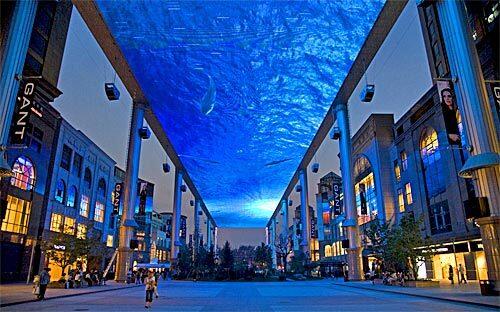
A gigantic video screen dwarfs shoppers at the Place in Beijing’s Central Business District, which was the focus of an Olympics update. Many of the Olympics organizers are working on preparations for for the 60th anniversary celebrations of the Communist revolution in October. (Chien-min Chung / For The Times)
With the 2008 Summer Olympics looming, the host city has gone on a wild building spree. Prepare to be wowed by the world-class transformation.
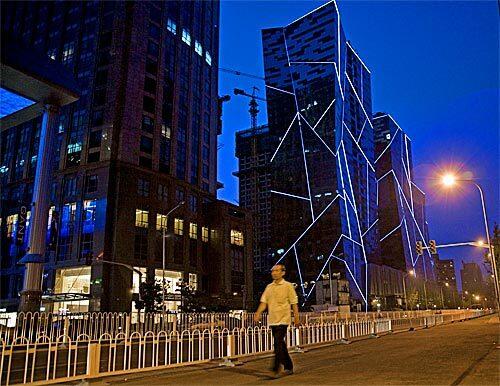
Avant-garde lighting draws attention to SOHO Shangdu, a huge office, retail and residential community in the Central Business District. The SOHO project, one of several that mixes work and play, is among the many developments that have risen in Beijing since the city’s transformation began in 2001, when it won its bid to host the 2008 Summer Games. (Chien-min Chung / For The Times)
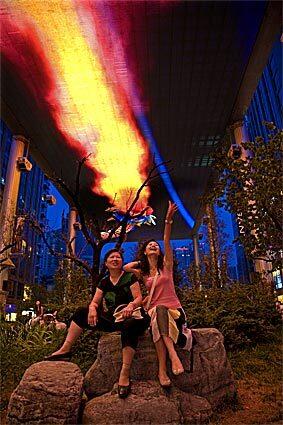
Shoppers enjoy the outdoor video screen at the Place mall in the Central Business District. The whopper LED screen -- it’s 98 feet wide -- is suspended over the mall’s courtyard; it shows movies, promotional videos, satellite TV and shoppers’ own digitally uploaded photos. Top that, the Grove! (Chien-min Chung / For The Times)
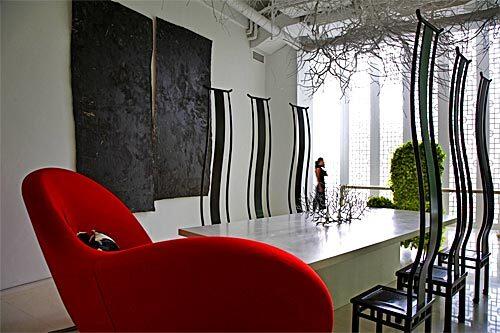
The Green T. House in the Chaoyang district is all sleek minimalism. The district’s contemporary look and conveniences have made it popular with embassies, multinational corporations, shopping mall developers and most of Beijing’s big chain hotels. From here, it’s a long haul on foot to the Forbidden City, but that will soon change: Once a new light-rail line opens next year, the district will become one of the city’s major transportation hubs, offering connections to the Forbidden City and the Olympic Green. (Chien-min Chung / For The Times)
Advertisement
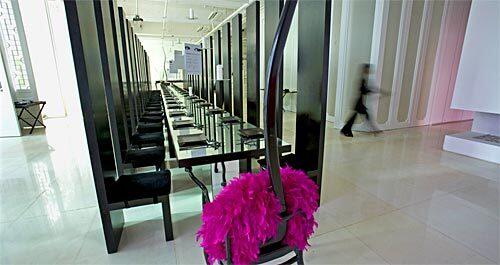
A spot of fuchsia adds whimsy to the stark decor at the Green T. House. The menu at the Asian fusion restaurant also borders on the whimsical: Offerings include “Kiss Me, Don’t Say Goodbye,” a dark chocolate-jasmine fondant, and “Snow Flake Yogurt Soup,” made of light and creamy cucumbers and delectable grilled prawns. Wash it down with a glass of iced apple tea. (Chien-min Chung / For The Times)
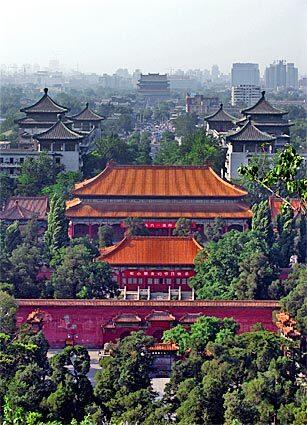
Beijing’s past and future: The Forbidden City rises in the foreground, while modern skyscrapers dot the skyline. In anticipation of the influx of visitors for next summer’s Olympics, ongoing restoration has intensified on some of the major sights in the Forbidden City, such as the Meridian Gate and the Hall of Supreme Harmony. (Susan Spano / LAT)
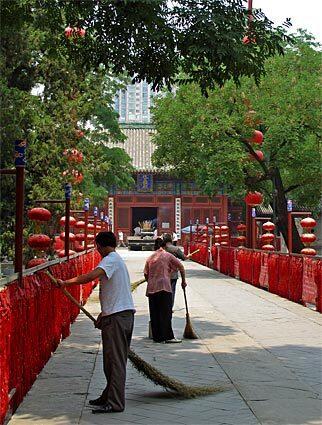
Beijing’s sidewalks get a clean sweep each morning. The government is working on the city’s image in other ways too: It’s planting millions of trees and urging people to correct such bad habits as spitting in public, talking too loudly and cutting in line. Even the taxis are not excluded: Drivers are deodorizing their cars. (Susan Spano / LAT)
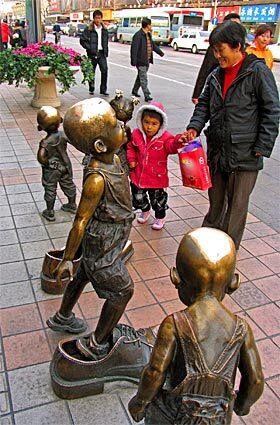
A child is entranced by a playful sculpture along Wangfujing, Beijing’s main shopping street. The Dongcheng district is also known for its old-fashionednarrow-alley hutong neighborhoods. The hutongs, which flow in a tangle toward big streets like streams trickling toward rivers, are lined with trees, tiny shops and low-rise courtyard residences, or siheyuans. The narrowest, Gaoxiao Hutong, is 2 feet wide; the shortest is Yichi Dajie Hutong, or One Foot Street. (Susan Spano / LAT)
Advertisement
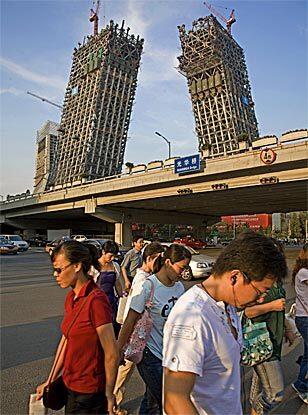
Rising on the Beijing skyline is the 755-foot CCTV Tower. The city’s newest and most noteworthy avant-garde architecture -- including Dutch architect Rem Koolhaas’ CCTV Tower -- clusters in the Central Business District along the Second Ring Road on the eastern side of the city. (Chien-min Chung / For The Times)
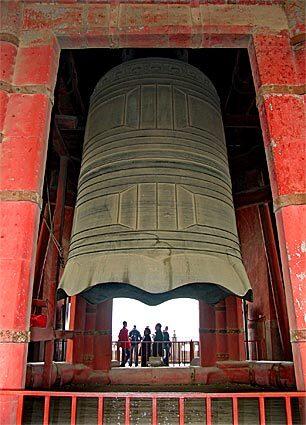
The 18th century Big Bell Temple in the Haidian district is named after -- you guessed it -- its giant bell. Visit at the right time, and the lucky tourist may hear a docent play a winsome Chinese air on the Marquis of Zeng’s 65 chimes at the temple. Beijing is dotted with bell towers, which are popular with sightseers. (Susan Spano / LAT)
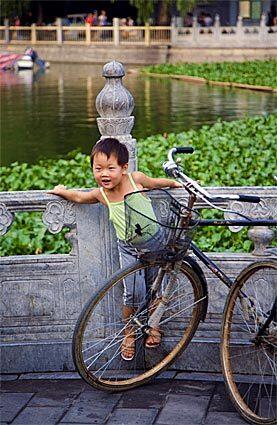
A young girl enjoys a warm afternoon at Houhai Lake, northwest of the Forbidden City. The lake is close to the Gulou Drum Tower. Although Beijing is rabidly transforming itself into a glossy capital for the 21st century, much of its ancient past still remains for residents and tourists to enjoy. (Chien-min Chung / For The Times)
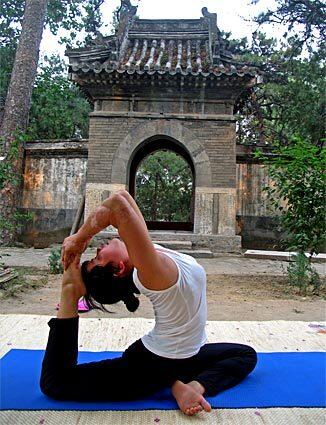
S-T-R-E-T-C-H: A teacher works on her postures in the courtyard of Mountain Yoga, a rustic retreat in a beautiful temple compound on the far reaches of Beijing. Visitors to Beijing rarely stray beyond the Second Ring Road, much less the Sixth. Perhaps they should -- there are mountains to the north and west, with reservoirs, hot springs and sleepy villages. And to the south and east, farm fields take over. There are many options for a weekend getaway, including yoga and artists’ retreats, and hiking stretches of the Great Wall. (Susan Spano / LAT)
Advertisement
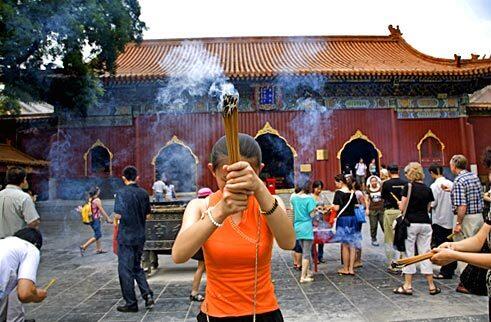
At the gloriously beautiful Lama Temple in the central city, Buddhist prayers include lighted incense. Kids in tow? They might like to buy incense from the vendors around the temple and then light it before various statues. (Chien-min Chung / For The Times)
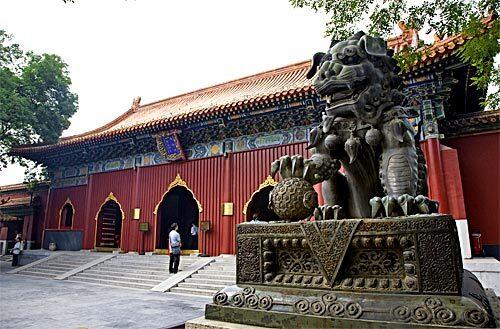
A statue of a male lion stands guard in front of a hall at Lama Temple in central Beijing. The temple is one of nine religious sites in the capital where Tibetan Buddhists once worshiped. (Chien-min Chung / For The Times)
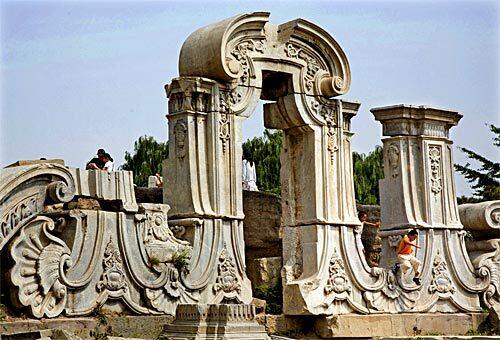
Yuanmingyuan, the Old Summer Palace, lies in ruins near Peking University. The palace was built in the 18th century, and the first Europeans who saw its interconnected gardens and pavilions, set on a system of man-made rivers, were so astounded by its splendors that they called it the “Versailles of the East.” But when the great powers of the 19th century began carving up China, first by treaty and then by force, Yuanmingyuan was sacked and burned. Today, all that’s left is rubble and whispers of the past. (Chien-min Chung / For The Times)
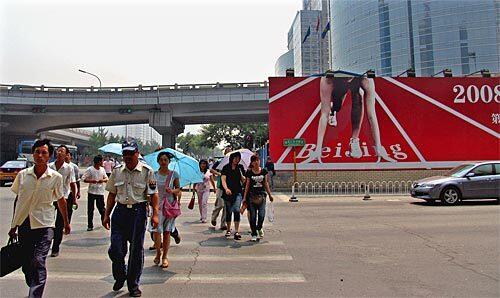
A billboard reminds Beijingers of the 2008 Games -- as if they didn’t know already! With the Olympics less than a year away, the host city is racing against the clock to have everything ready for its international moment in the sun. (Susan Spano / LAT)
Advertisement
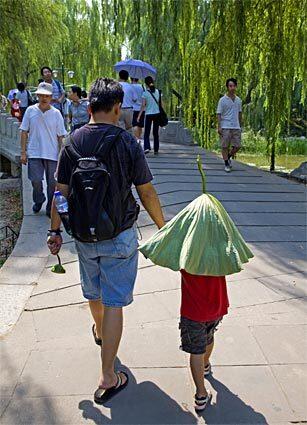
No parasol on a hot, sunny stroll through a Beijing park? No problem! A young boy finds shade the natural way: under a large plant leaf. (Chien-min Chung / For The Times)



